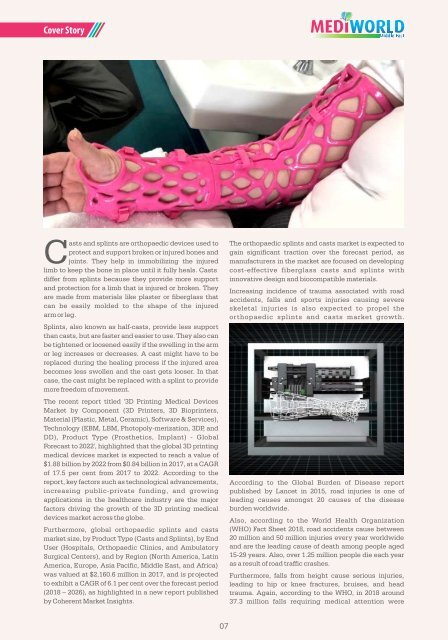Mediworld September-October 2018_Final Draft
You also want an ePaper? Increase the reach of your titles
YUMPU automatically turns print PDFs into web optimized ePapers that Google loves.
Cover Story<br />
asts and splints are orthopaedic devices used to<br />
Cprotect and support broken or injured bones and<br />
joints. They help in immobilizing the injured<br />
limb to keep the bone in place until it fully heals. Casts<br />
differ from splints because they provide more support<br />
and protection for a limb that is injured or broken. They<br />
are made from materials like plaster or fiberglass that<br />
can be easily molded to the shape of the injured<br />
arm or leg.<br />
Splints, also known as half-casts, provide less support<br />
than casts, but are faster and easier to use. They also can<br />
be tightened or loosened easily if the swelling in the arm<br />
or leg increases or decreases. A cast might have to be<br />
replaced during the healing process if the injured area<br />
becomes less swollen and the cast gets looser. In that<br />
case, the cast might be replaced with a splint to provide<br />
more freedom of movement.<br />
The recent report titled '3D Printing Medical Devices<br />
Market by Component (3D Printers, 3D Bioprinters,<br />
Material (Plastic, Metal, Ceramic), Software & Services),<br />
Technology (EBM, LBM, Photopoly-merization, 3DP, and<br />
DD), Product Type (Prosthetics, Implant) - Global<br />
Forecast to 2022', highlighted that the global 3D printing<br />
medical devices market is expected to reach a value of<br />
$1.88 billion by 2022 from $0.84 billion in 2017, at a CAGR<br />
of 17.5 per cent from 2017 to 2022. According to the<br />
report, key factors such as technological advancements,<br />
increasing public-private funding, and growing<br />
applications in the healthcare industry are the major<br />
factors driving the growth of the 3D printing medical<br />
devices market across the globe.<br />
Furthermore, global orthopaedic splints and casts<br />
market size, by Product Type (Casts and Splints), by End<br />
User (Hospitals, Orthopaedic Clinics, and Ambulatory<br />
Surgical Centers), and by Region (North America, Latin<br />
America, Europe, Asia Pacific, Middle East, and Africa)<br />
was valued at $2,160.6 million in 2017, and is projected<br />
to exhibit a CAGR of 6.1 per cent over the forecast period<br />
(<strong>2018</strong> – 2026), as highlighted in a new report published<br />
by Coherent Market Insights.<br />
The orthopaedic splints and casts market is expected to<br />
gain significant traction over the forecast period, as<br />
manufacturers in the market are focused on developing<br />
cost-effective fiberglass casts and splints with<br />
innovative design and biocompatible materials.<br />
Increasing incidence of trauma associated with road<br />
accidents, falls and sports injuries causing severe<br />
skeletal injuries is also expected to propel the<br />
orthopaedic splints and casts market growth.<br />
According to the Global Burden of Disease report<br />
published by Lancet in 2015, road injuries is one of<br />
leading causes amongst 20 causes of the disease<br />
burden worldwide.<br />
Also, according to the World Health Organization<br />
(WHO) Fact Sheet <strong>2018</strong>, road accidents cause between<br />
20 million and 50 million injuries every year worldwide<br />
and are the leading cause of death among people aged<br />
15-29 years. Also, over 1.25 million people die each year<br />
as a result of road traffic crashes.<br />
Furthermore, falls from height cause serious injuries,<br />
leading to hip or knee fractures, bruises, and head<br />
trauma. Again, according to the WHO, in <strong>2018</strong> around<br />
37.3 million falls requiring medical attention were<br />
07

















